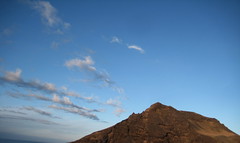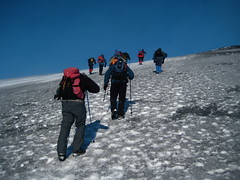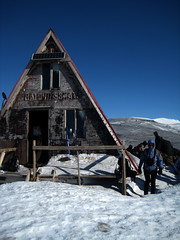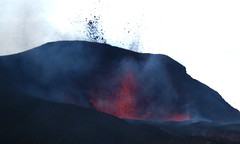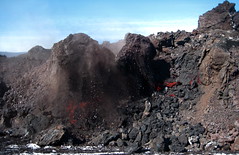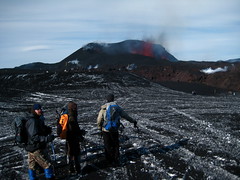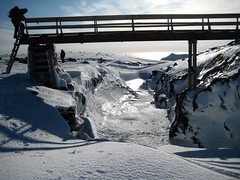Path to Fire
On a sunny Saturday in March 2010 I went for one of the coolest — yet hottest — hikes I have ever done. The path lay up onto the mountain range Fimmvörðuháls — between the glaciers Eyjafjallajökull and Mýrdalsjökull — in the southern highlands of Iceland. It was a cold day with freezing temperatures of minus ten to minus fifteen degrees centigrade. The destination was one of the hottest ones in Iceland at the time — an erupting crater in the northern part of the Fimmvörðuháls mountain range.
The hike started at Skógar shortly after sunrise. We started early to make the most of the frozen snow. We followed the road up onto the mountain range. First through the half frozen mud but soon to be replaced by a thick cover of snow.
We marched onward against the cold northern wind. Freezing on the outside, but on the inside, we were burning in anticipation to see mother nature at work. We walked through the white snow. Snow that gradually turned more gray as it got mixed with particles of black ash from the erupting crater.
After several hours of hiking we reached Baldvinsskáli — a cabin close to the top of the Fimmvörðuháls mountain range. It was an ideal place for reaching down into our backpacks for some fuel in the form of sandwiches and hot cacao.
After the short fuel stop we continued walking over the hills ahead, hoping that the next hill would be the one from which we would see the eruption in its full glory. After a couple of disappointments we finally reached a hilltop where we could see an occasional pack of red hot lava being blown up in the air from behind the opposite hill. We were getting close.
Despite having hiked for five hours and overcome a thousand meters elevation difference we were full of excitement and almost ran down the hill and up the slopes of the next one. The hill was crowded with spectators admiring the view. The view was jaw-dropping. We could see the crater clearly. It was on the opposite hill. In between, there was a small valley where the thick cover of lava moved slowly toward us.
It is hard to describe with words the sheer power of the forces of nature. We could see the hot magma being blown in the air accompanied with loud booming explosions. In the background we could hear a constant rattling sound of the lava front moving forward. The sight was breathtaking.
Having admired the eruption from a safe distance for a while we ventured into unsafer territory. We went down into the valley — to the lava front. We could see the lava moving forward and occasionally a big block would fall down, leaving a glowing wound of red hot magma.
At the lava front we encountered occasional showers. At first I thought it was hail, but after running my hand over my cap I realized it was a shower of ash coming from the crater. The wind was blowing the ash into our nose and mouth making it a multi-sense experience. We could see the eruption, hear it, smell it and taste it.
All fun must come to an end. After a while at the lava front we reluctantly admitted that it was time to leave the eruption behind and head back. We started walking away from the lava front, frequently looking back over our shoulder to get the last glimpse of the crater.
We reached Skógar again after about 10 hours of hiking. It was a demanding 30 kilometers hike against the cold northern wind. We were completely exhausted upon our return. Yet, it was certainly worth every minute and a once-in-a-lifetime experience — so far. It was a breathtaking acquaintance with the powerful forces of mother nature.
